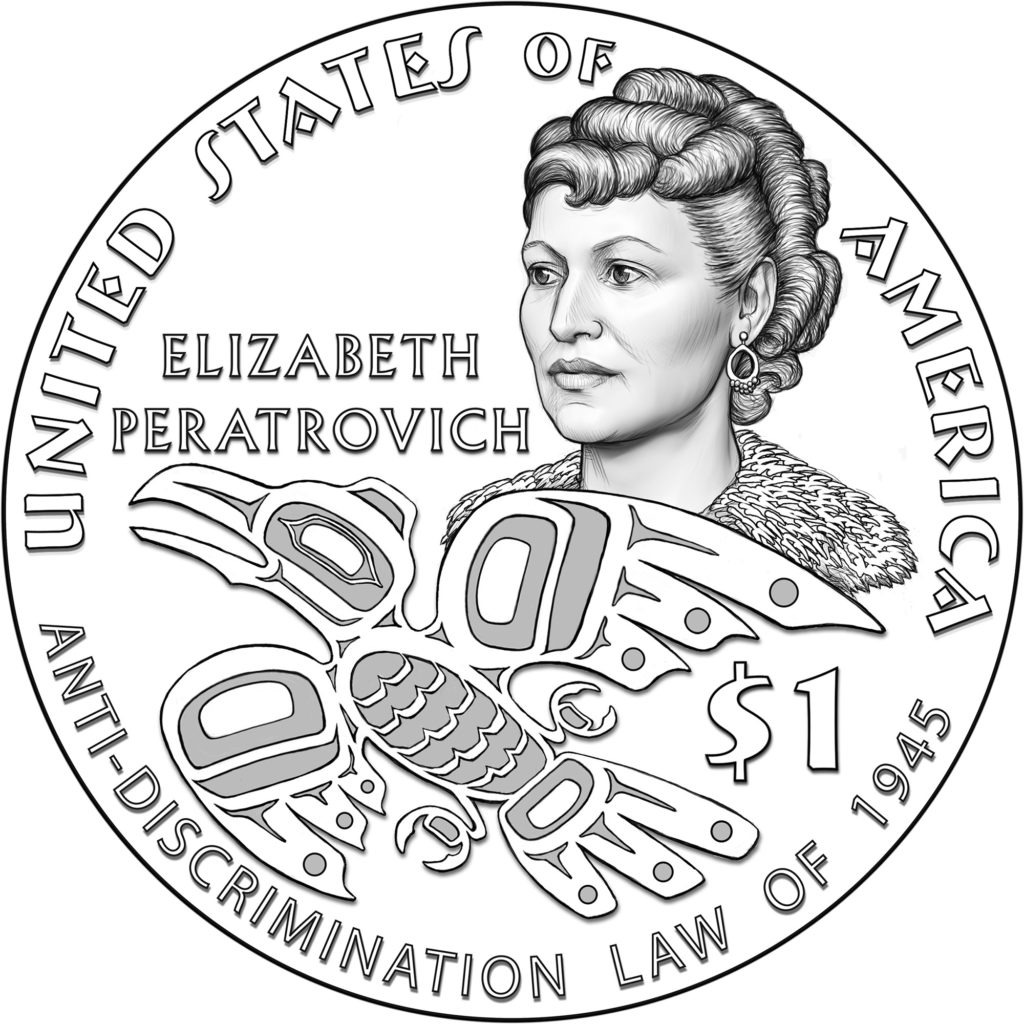
October 6, 2019; Indian Country Today
“The US Mint announced last week that it will honor Elizabeth Peratrovich, Tlingit, on the 2020 dollar coin,” writes Joaqlin Estus in Indian Country Today. The coin design was unveiled this past Saturday at Alaska Pacific University in Anchorage by US Mint Chief Administrative Officer and Acting Deputy Director Patrick Hernandez.
“Next year it will be our great privilege to connect America to the powerful message of hope and perseverance in the face of discrimination,” Hernandez said at the ceremony. “We will proudly honor an Alaska Native who was a tireless advocate for Native peoples and an inspiration to the civil rights movement.”
Although the practice gets little attention, since 2000 the US Mint has issued dollar coins honoring Native Americans. From 2000 to 2008, the dollar coin honored Sacagawea, a Lemhi–Shoshone woman who served as an interpreter for Merriweather Lewis and William Clark on their famed expedition from St. Louis to the Pacific Ocean.
Beginning in 2009, while Sacagawea was kept on the heads side of the coin, it was decided to rotate a different Native American image on the tails side each year. Often themes or groups are honored, rather than individuals. (For instance, the 2016 coin honored World War II code talkers.) Peratrovich is the third individual since Sacagawea to be honored in the coin series. The other two were Sequoyah, who created the Cherokee written language and was on the 2017 coin, and Jim Thorpe, the Olympic athlete, raised in the Sac and Fox tribe, who was on the 2018 coin.
Who was Elizabeth Peratrovich?
Sign up for our free newsletters
Subscribe to NPQ's newsletters to have our top stories delivered directly to your inbox.
By signing up, you agree to our privacy policy and terms of use, and to receive messages from NPQ and our partners.
She was an accomplished advocate. Estus notes, “In 1945 Peratrovich gave a passionate speech to the Alaska Territorial Legislature that is credited with convincing legislators to adopt the Alaska Anti-Discrimination Law.” The date that bill was signed into law, February 16th, is now known in Alaska as Elizabeth Peratrovich Day.
A New York Times obituary of Peratrovich, published earlier this year as a part of the “Overlooked No More” obituary series, noted the Alaska law that Peratrovich championed passed in Alaska 19 years prior to the 1964 Civil Rights Act, making Alaska’s the first post-Reconstruction anti-discrimination law passed in the United States. The law entitled all Alaskans to “full and equal enjoyment” of public establishments.
Prior to the passage of the 1945 law, the territory had “separate schools, hospitals, theaters, restaurants and cemeteries” for Alaskan Natives and whites, notes Catherine Vaughn in the New York Times. Hotels were also segregated, and it was after being denied entry to a Juneau hotel in 1941 that Peratrovich and her husband Roy began to campaign for the civil rights law. The first effort to pass it failed on an 8-8 tie vote in the House in 1943. Two years later, Peratrovich and her allies succeeded in getting the law passed by a margin of 11 to 5.
Jackie Pata, Tlingit, a former director of the National Congress of American Indians (NCAI), says that Peratrovich’s activism continued far beyond the Alaskan civil rights campaign, noting, “she went on to fight for healthcare, for education rights. She went to NCAI…She became an executive committee member there and she fought for the rights of Alaska Natives to be members of that organization, which many of our tribes today participate in.” Peratrovich died early of breast cancer, at the age of 47, in 1958.
Each year’s design, notes the US Mint’s website, is “selected by the Secretary of the Treasury after consulting with the US Senate Committee on Indian Affairs, the Congressional Native American Caucus of the US House of Representatives, the Commission of Fine Arts and the National Congress of American Indians, and after public review by the Citizens Coinage Advisory Committee.”—Steve Dubb













